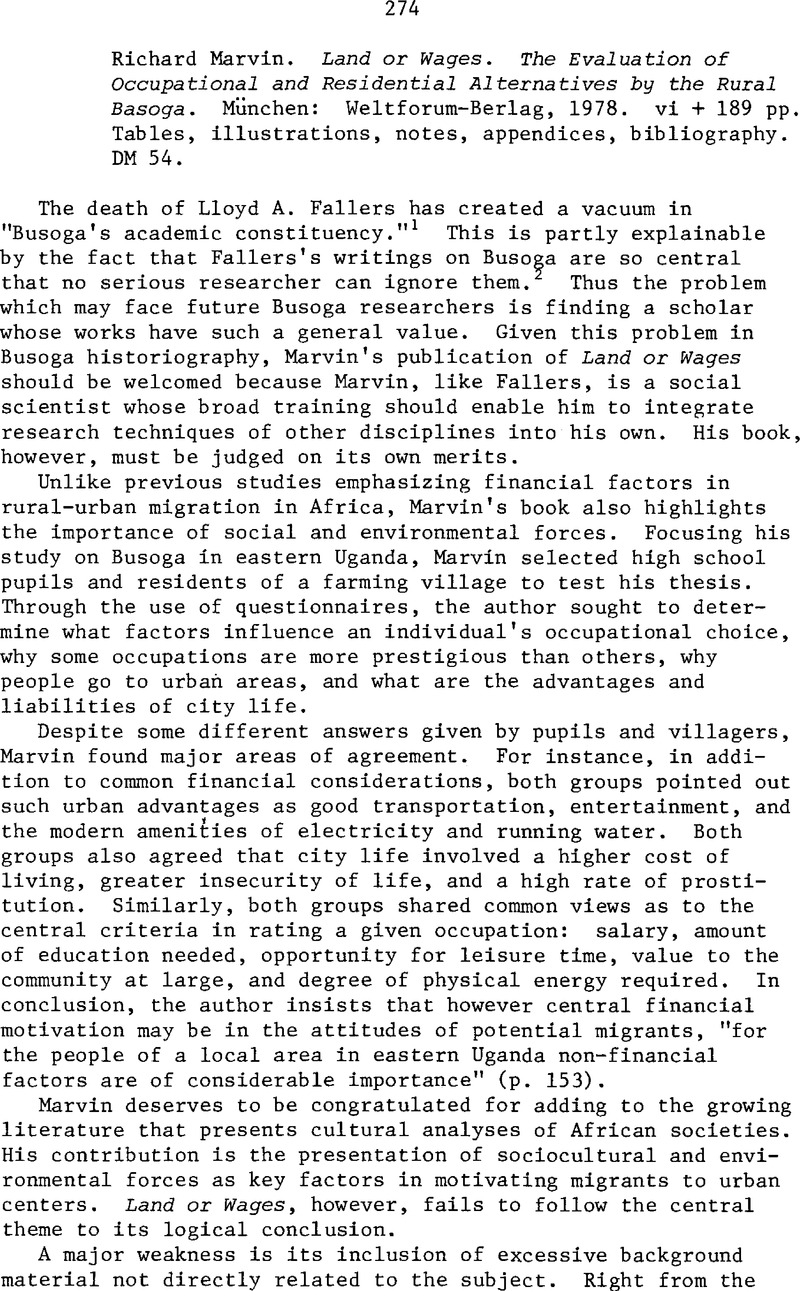No CrossRef data available.
Article contents
Richard Marvin. Land or Wages. The Evaluation of Occupational and Residential Alternatives by the Rural Basoga. München: Weltforum-Berlag, 1978. vi + 189 pp. Tables, illustrations, notes, appendices, bibliography. DM 54.
Published online by Cambridge University Press: 23 June 2016
Abstract

- Type
- Review Articles and Reviews
- Information
- Copyright
- Copyright © African Studies Association 1980
References
1. The phrase “Busoga’s academic constituency” was coined by Dr.Mudoola, Dan, Department of Political Science, University of Dar es Salaam, Tanzania Google Scholar, and refers to the perimeters in which scholarly work has been conducted in Busoga District, Uganda.
2. Fallers, Lloyd A., Bantu Bureaucracy (Cambridge: W. Heffer and Sons, Ltd., 1956)Google Scholar, and Law Without Precedent (Chicago: The University of Chicago Press, 1969).
3. Among the major omissions are: Fallers, Bantu Bureaucracy; Harlow, Vincent and Chilver, E. M., eds., History of East Africa (Oxford: Clarendon Press, 1965), vol. 2 Google Scholar; Larimore, A. E., The Alien Town, Department of Geography, Research Paper No. 55 (Chicago: The University of Chicago Press, 1958)Google Scholar; Powesland, P. G., Economic Policy and Labour, East African Studies, No. 10 (Kampala: East African Institute of Social Research, 1957)Google Scholar; Richards, A. I., ed., Economic Development and Tribal Change (Cambridge: Heffer and Sons, 1954)Google Scholar; Sofer, Cyril and Sofer, Rhona, Jinja Transformed, East African Studies, No. 4 (Kampala: East African Institute of Social Research, 1955)Google Scholar; Southall, A. and Gutkind, P. C. W., Townsmen in the Making, East African Studies, No. 9 (Kampala: East African Institute of Social Research, 1956)Google Scholar; and Wrigley, C. C., Crops and Wealth in Uganda, East African Studies, No. 12 (Kampala: East African Institute of Social Research, 1959)Google Scholar.
4. For a good interpretation of the value of oral traditions as a historical source, see Jackson, Kennell A. Jr., “Review Essay: Oral Traditions Past, Oral History Future,” Journal of African Studies 4, 3 (1977): 319–343 Google Scholar.
5. Among the recent researches on Busoga are: Cohen, David W., The Historical Tradition of Busoga (Oxford: Clarendon Press, 1972)Google Scholar, and Womunafu’s Bunafu (Princeton, N. J.: Princeton University Press, 1977); Tom, A. D. Tuma, “The Introduction and Growth of Christianity in Busoga, with Particular Reference to the Roles of the Basoga Clergymen, Catechists and Chiefs” (Ph.D. thesis, University of London, 1973)Google Scholar; Mudoola, Dan M., “Chiefs and Political Action, the Case of Busoga, 1900-1962” (Ph.D. thesis, Makerere University, Kampala, 1974)Google Scholar; and F. P. Nayenga Batala, “An Economic History of the Lacustrine States of Busoga, Uganda: 1750-1939” (Ph.D. dissertation, University of Michigan, Ann Arbor, 1976).
6. Nayenga, Peter F. B., “Busoga in the Era of Catastrophes, 1898-1911,” in Ogot, Bethwell A., ed., Ecology and History in East Africa (Nairobi: Kenya Literature Bureau, 1979), pp. 153–178 Google Scholar.
7. See, for instance, Langlands, B. W., The Population Geography of Busoga District, Occasional Paper No. 40, Department of Geography (Kampala: Makerere University, 1971)Google Scholar; Soff, Harvey G., trans., Sleeping Sickness in the Lake Victoria Region of British East Africa, 1900-1915, The Program of Eastern African Studies, Occasional Paper No. 46 (New York: Syracuse University, 1968)Google Scholar; and Watts, Susan J., The South Busoga Resettlement Scheme, The Program of Eastern African Studies, Occasional Paper No. 17 (New York: Syracuse University, 1966)Google Scholar.
8. Nayenga, Peter F. B., “Chiefs and ‘the Land Question’ in Busoga District, Uganda, 1895-1939,” International Journal of African Historical Studies 12, 2 (1979): 183–209 CrossRefGoogle Scholar.
9. Fallers, Law Without Precedent, pp. 200-255.


